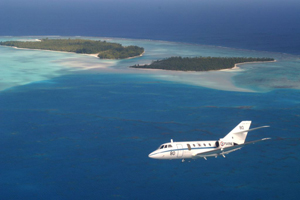
MARITIME SURVEILLANCE AIRCRAFT
|
HISTORY |
Birth of the program
In 1961 the Dassault design
team, led by Paul Déplante, Paul Chassagne and Ren2 Lemaire decided
to give a second chance to the " Méditerranée "
( a corporate jet prototype). The Mystère 20 (the new plane's first
name) was capable of transporting ten passengers at a cruising speed of
Mach 0.8.
|
Because of it's limited range (1,000 to 1,5000km), the new plane was at first designed for the european market only. But the american market was becoming more important every day, and Dassault eventually decided to increase the plane's performances to 2,000km. The Mystère 20 actually benefitted from many technical advances made available by the Ouragan-Mystère and Mirage fighters. It was built by Sud-Aviation. The prototype made it's maiden flight on May 4th 1963, flown by René Bigand. At the same time PanAm (Pan American World Airlines) was considering opening a new branch, designed around corporate travelling. PanAm vice-president Gledhill, accompagnied by Charles Lindbrgh visited and flew the prototype (Mystère 20-01), and on August 2nd 1963 the company placed a firm order for 40 planes and an option for a further 120, all powered by GE CF-700 engines. |
|
With the French Naval Aviation
Concept
In June 1977 the French Navy had to
take into account the increase of its needs in maritime surveillance platforms,
mainly due to the progressive extension (to 200miles) of France's economic
exclusivity zone.
The Navy was looking for an aircraft to replace the ageing Lockheed P-2H
Neptune (P2V-7), to fullfill maritime patrol and surveillance missions
with squadrons 9.S and 12.S in the Pacific. The specifications were for
a very fast plane, capable of rapid altitude changes. Further requirements
were : at least two engines (for safety reasons), being able to rapidly
reach isolated zones, being able to patrol wide zones for a long time.
The plane was to be fitted with state of the art navigation and detection
equipment, both reliable and sturdy. Since it was going to operate from
isolated and summary bases, it had also had to be easy and fast to service.
Using the experience gained with the HU-25A Guardian ; Dassault then offered
a smal twin-engined jet meeting thes specifications and well suited for
maritime surveillance. The Gardian avionnics suit comprises a Varan radar
(optimized to detect small objects in rough seas), a Crouzet navigation&attack
system, a calculator and finally an automatic navigation chart. It is
also equipped with a hatch in the floor to drop survival gear and marking
devices, and eventually to evacuate the crew. The Gardian has two big
obervation windows on each side of the fuselage, and 4 hardpoints under
the wings for heavy loads ( various sensors, target towing cases, EM and
IR counter measures).
The planes have four main missions
:
-Search and Rescue (SAR)
-Law enforcement (ELT)
-Maritime environment protection (MEP)
-Scientific and Maritimes Experimentation (MSA)
From the first tests
to service entry
The first Gardian, a modified Falcon
20H, by then known as the Falcon 200, made it's first flight at Merignac
on April 24th 1979, flown by Henri Suisse and Jean-Marie Barthelemy. The
first production airframe (n°48) rolled out of the Merignac factory
on March 18th 1981 and made its first flight on April 15th with Hervé
Leprince-Ringuet (pilot) and JM Barthelemy (flight test engineer) in the
cockpit. This crew went on to perform all the tests and evaluations of
the Gardian with the CEV (Centre d'Essais en Vol/Test Flight Center).
The French Navy officially placed the order for 5 planes on May 13th 1981.
This deal included the development and manufacturing of 5 airframes, to
be delivered on two batches, a first batch of two airframes and a second
one of three. Gardian n°48 was handed over to the Navy the same day.
The CEPA (Naval Aviation Practical Experimentations Center) Gardian detachment
was opened on September 13th 1982 at Istres ; it closed in July 1984.
|
Type |
Construction |
S/n |
Naval aviation number |
Former code |
|
Gardian |
1982 |
448 |
48 |
F-ZWVF |
|
Gardian |
1983 |
465 |
65 |
F-ZJTS |
|
Gardian |
1983 |
472 |
72 |
F-Z... |
|
Gardian |
1983 |
477 |
77 |
F-Z... |
|
Gardian |
1984 |
480 |
80 |
F-ZJSA |
With flights 9.S and 12.S flights (1983-2000)
On April 14th 1983 the first Gardian was officially handed over to Admiral Leenhardt, Navy Chief of Staff, by Bruno-Claude Vallières.
|
|
The
first sea rescue operation |
|
|
Furthermore, unlike the Coast-Guard Guardians that perform only civilian duties in peacetime, french Gardians are fully integrated in military operations : they often work alongside Navy vessels, and until the end of nuclear tests in the Pacific, they were in charge of the surveillance of the Pacific Experimentation Center (CEP). Today their main mission in the Pacific is the surveillance of France's exclusive economic zone (which represents no less than 6 million sq/km) and SAR. |
|
25.F squadron (since
2000)
|
Asleep since July 23rd 1983, this squadron was reactivated on September 1st 2000 when flights 9.S and 12.S merged. Head-Quarters are based at NAS Tahiti-Faa (with two planes). Detachments are sent to NAS Tontouta (one plane) and Fort-de-France in the west indies (one plane). Approximatively 2,100 hours are flown every year on the three operating theaters. |
|
|
|
sources - acknowledgements :
"Avion Marins" Luc Berger - Dassault Aviation
- 1998.
Marine
Nationale
©French Fleet Air Arm. www.ffaa.net. All rights reserved.



